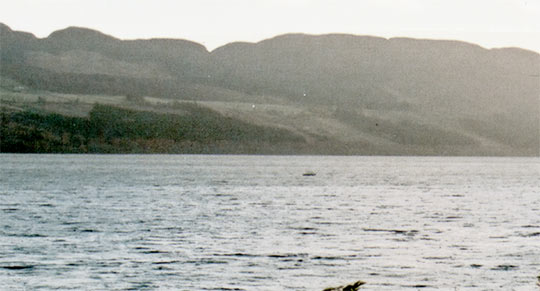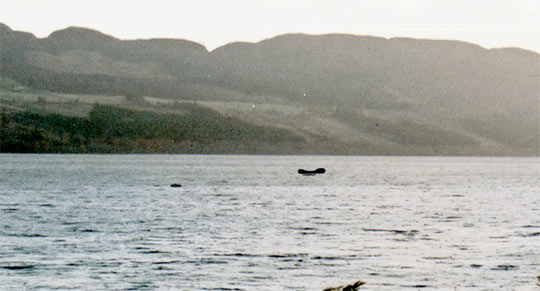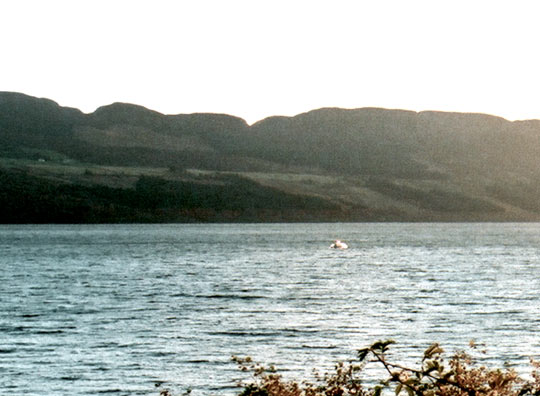The Loch Ness Project 
Loch Ness
Centre
|
||||
A new development reflecting the popularity of Loch Ness, is the use of webcams, most notably (www.lochness.scotland.net/) , making the loch accessible in a way that it has never been before. It may be thought that the combination of a relatively low resolution tool in the hands of unprecedented numbers of people with no experience whatever of the loch's conditions would be a sure recipe for a sightings bonanza. Interestingly, this has not proved to be the case. Less than half a dozen have come to our attention. There is one however, which has come to particular public attention. On June 20th 2000, Gavin Joth,
a resident of Victoria, British Columbia, was taking a
lunch break when he took a screen-grab from the Scotland
on Line webcam pointing across Urquhart Bay at Loch Ness,
where the local time was 8.30pm. A moving object was captured
in a series of frames, heading out of view towards the
right. Mr. Joth felt that the object was larger than a human head but smaller than a boat and it was therefore on the basis of size that the object was considered of interest. After examination by the British Columbia Scientific Cryptozoological Club, its president, John Kirk III, was reported to have said that usual explanations such as seals and boats could be discounted. The pictures subsequently shared the £1000 prize from the British bookmakers, William Hill for the best Nessie picture of the year. One of the advantages of webcams which partly offsets the resolution problem, is that they are in place long term in known positions, so it is relatively easy to reconstruct some of the factors in a given event. On May 3rd 2001, the Loch Ness Project set out to test the size of the object empirically. With the co-operation of Scotland on Line,
the webcam was trained to the same view as during the
incident. Mr. Joth's picture was then superimposed on
the view to give a position for the object of interest.
Mr Gordon Menzies then guided the Project's vessel Deepscan
to the spot by radio while he observed the computer screen.
Project members Adrian
Shine and John Minshull were accompanied by Dick
Raynor as they took GPS position fixes and placed Deepscan
stern-on to the camera. The picture below suggests that
the object certainly has a lesser height than Deepscan
(Length 32ft, Beam 12ft and Height 8ft 6ins) and perhaps
a slightly lesser beam. On the basis of the above experiment, we conclude that the object was not smaller than a boat of the type described and may have been slightly larger.
The co-winners of the William Hill prize provide an interesting case at the other extreme of the size argument. On July 13th 2000 Melissa Bavister and Chris Rivett took a photograph from a lay-by on the A 82 north shore road, a little to the south of Tor Point. Nothing unusual was seen at the time but upon development the picture showed a large object with a boat in the foreground. The couple had no recollection of a boat on the loch at the time but considered the larger image to be of interest since it appeared to have two humps. Various authorities have stated that the negatives are intact and that the image is not a speck on the film. Jim Cordiner, senior lecturer in photography at the Glasgow College of Building and Printing is reported to have said that "its shape does not lend itself to being a boat or other man made object. This leaves the only realistic possibility - that it is a photo of some unknown creature in the loch". Again the empiric scaling method was
conducted by the Loch Ness Project in November 2000 with
the result that the object could be seen to be over 70ft
long and 10ft high, exceeding even the most unrealistic
estimates of size for Loch Ness Monsters!
A mathematical treatment has been completed by Dick Raynor (www.lochnessinvestigation.org/) with similar results. Raynor has also shown that the best match for the image is one of the barges operating on the loch seen at an oblique angle. These vessels are over 100ft long and are of the indicated height. The most common cause of interesting objects only noted after film processing are passing seagulls but boats are also too commonplace to be recalled unless they are the subject of the photograph. Clearly, an unrecognised object of this scale would hardly have escaped the observer's attention at the time. It may be concluded therefore, that it was recognised at the time as commonplace but was naturally forgotten afterwards. Copyright: Loch Ness Project 2001
|



